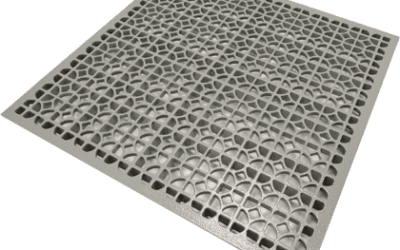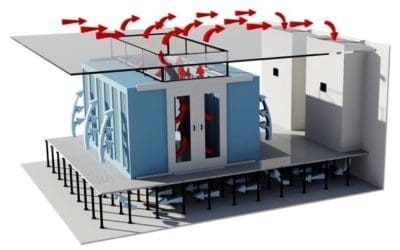In modern data centre environments, airflow is a foundational element of thermal performance, but also one of the most commonly mismanaged.
Across Tier I to Tier III facilities, airflow inefficiencies continue to compromise uptime, elevate energy consumption, and diminish the effectiveness of even the most advanced cooling systems.
EziBlank was developed to address these challenges precisely where they begin: at the intersection of airflow design and operational simplicity.
Below are five common mistakes seen in data centre airflow management, and how EziBlank solves them through modular, sustainable engineering.
1. Leaving Rack Units Open Without Blanking Panels
Open RU spaces within server racks disrupt the expected flow of cold and hot air. In the absence of proper blanking, exhaust air recirculates into intake zones, leading to elevated temperatures and unnecessary load on cooling infrastructure.
This imbalance not only drives up energy consumption but also reduces the effective lifespan of IT equipment by exposing it to thermally inconsistent conditions.
EziBlank offers a line of modular blanking panels engineered for seamless tool-free installation across 19″, 21″, and 23″ racks. Designed with snap-on clips and UL-94 V0 flame-retardant ABS, these panels maintain airflow integrity without adding installation complexity.
Their reusability and rack compliance make them especially suited for data centres evolving toward higher rack density and efficient capacity planning.
With precision blanking applied to every open RU, facilities can maintain proper pressure differentials and reduce recirculation without increasing fan speeds or lowering setpoints.
2. Failing to Seal Cable Cutouts and Underfloor Gaps
Cable pass-throughs and unsealed cutouts within raised floors are often overlooked. These openings allow conditioned air to escape into unmanaged areas, contributing to bypass airflow and undermining the effectiveness of perforated tile layouts. Over time, this creates thermal unpredictability and a false sense of cooling adequacy.
To address this, EziBlank provides dual-layer brush grommets that combine cable flexibility with airflow control. These grommets are designed to seal around dense cabling environments while maintaining underfloor pressure.
By integrating brush grommets into high-cable-volume zones, such as those near PDUs or switch cabinets, data centres gain an immediate reduction in cold air leakage, without disrupting cable routes or system layouts.
These solutions support efforts toward airflow zoning and provide an effective foundation for more advanced thermal optimisation strategies, including DCIM integration and CFD modelling.
3. Misplacing or Overusing Raised Floor Tiles
Raised floor systems are a staple of data centre design, yet they remain one of the most misunderstood airflow tools. When directional tiles are installed in non-critical zones or cold aisles are oversupplied with perforated tiles, the result is excessive bypass airflow.
This reduces cooling efficiency and forces CRAC units to compensate for conditions that could otherwise be corrected with targeted airflow delivery.
EziBlank solves this with its range of directional airflow floor tiles, engineered in cast aluminium and powder-coated for longevity in high-traffic zones.
These tiles are not passive grates; they are airflow management instruments capable of controlling both volume and direction through optional damper mechanisms.
When placed with thermal load data in mind, they reduce recirculation and deliver cooling where it’s required most.
Directional tile placement is particularly effective when paired with EkkoSense’s AI-driven thermal monitoring, ensuring cold air is directed only toward high-density intake areas.
4. Skipping Aisle Containment Strategies
Without proper aisle containment, thermal zones within the data centre become undefined. Cold and hot air intermingle in unpredictable ways, forcing cooling systems to compensate with higher airflow volumes or lower temperatures.
This compromises ΔT control and raises PUE values, particularly in facilities managing mixed legacy and high-density loads.
EziBlank addresses this through the EziBlank Wall system, a modular containment solution designed for modern cold aisle isolation. These wall-mounted panels are engineered not only for performance but also for visual integration.
Their clean, architectural design brings clarity and order to thermal zones while improving both form and function within IT spaces.
Installation is intuitive and retrofittable, allowing containment to be implemented without reengineering floor layouts. When paired with raised floor airflow systems and blanking panels, these walls reinforce the airflow loop, enabling measurable reductions in hot aisle mixing and providing a stable environment for temperature-sensitive workloads.
5. Ignoring Real-Time Thermal Optimisation
Static setpoints and manual cooling strategies are no longer sufficient in dynamic IT environments. Facilities that operate without live thermal insights often experience cooling redundancy, hidden hot spots, and overprovisioned airflow that wastes energy without improving resilience.
EziBlank’s partnership with EkkoSense brings AI-powered optimisation directly into the heart of thermal management. The platform builds a real-time digital twin of the data centre, offering visibility into airflow, heat maps, and cooling efficiency at a granular level.
Through continuous monitoring and machine learning, EkkoSense identifies imbalances across rows, detects airflow bottlenecks, and provides intelligent recommendations for airflow improvement.
When combined with modular hardware such as blanking panels, directional tiles, and containment, these insights translate into tangible performance gains, from increased equipment lifespan to measurable reductions in cooling energy use.
Why Engineers Choose EziBlank for Airflow Integrity
Airflow management is not a secondary consideration; it is central to the performance and sustainability of every data centre. Across three continents, engineers rely on EziBlank’s tool-free, reusable solutions to bring order, clarity, and efficiency to airflow systems.
From modular blanking panels that eliminate recirculation zones, to brush grommets that seal cable penetrations, to digital platforms that visualise thermal risk in real time, EziBlank is designed to work in harmony with both new builds and legacy retrofits.
Every product reflects the brand’s guiding principle: efficiency is holistic. EziBlank exists to make airflow management simpler, more precise, and more sustainable, one rack, tile, and aisle at a time.
Conclusion: Start with Airflow. Solve the Rest.
Data centre operators and engineers continually face the pressure to do more with less, less space, less energy, and fewer cooling resources. Addressing airflow missteps is one of the most direct and cost-effective paths to achieving that goal.
Whether it’s through modular blanking panels, raised floor airflow systems, or AI-based optimisation tools like EkkoSense, EziBlank delivers solutions that scale with your environment, cleanly, efficiently, and without unnecessary complexity.
To explore how airflow management can improve your facility’s resilience, thermal performance, and long-term sustainability, start with a system that’s built for precision.
Book a tailored airflow consultation or explore our full range of airflow products today.
Frequently Asked Questions
What is the purpose of a blanking panel in a data centre?
A blanking panel covers empty RU spaces in server racks to prevent hot air from recirculating into the cold aisle. This helps maintain airflow integrity, reduces cooling load, and supports consistent intake temperatures.
Do brush grommets improve underfloor cooling performance?
Yes. Brush grommets seal floor cutouts where cables enter the rack space. By containing airflow around cable penetrations, they help prevent cold air leakage and support efficient pressure management under raised floors.
What’s the difference between directional tiles and perforated tiles?
Directional tiles control the direction and flow volume of cooled air, making them suitable for targeting high-density rack zones. Perforated tiles, on the other hand, release air in an uncontrolled pattern, which can contribute to bypass airflow when not placed correctly.
Can containment walls be added to an existing facility?
Absolutely. EziBlank Wall panels are modular and designed for both new builds and retrofits. They mount easily to existing flooring or structural elements, creating defined thermal zones without construction disruption.
How does EkkoSense help optimise airflow?
EkkoSense uses AI-powered digital twins to provide real-time visibility into thermal conditions. It identifies airflow inefficiencies and cooling oversupply, allowing data centre teams to take precise corrective action.




